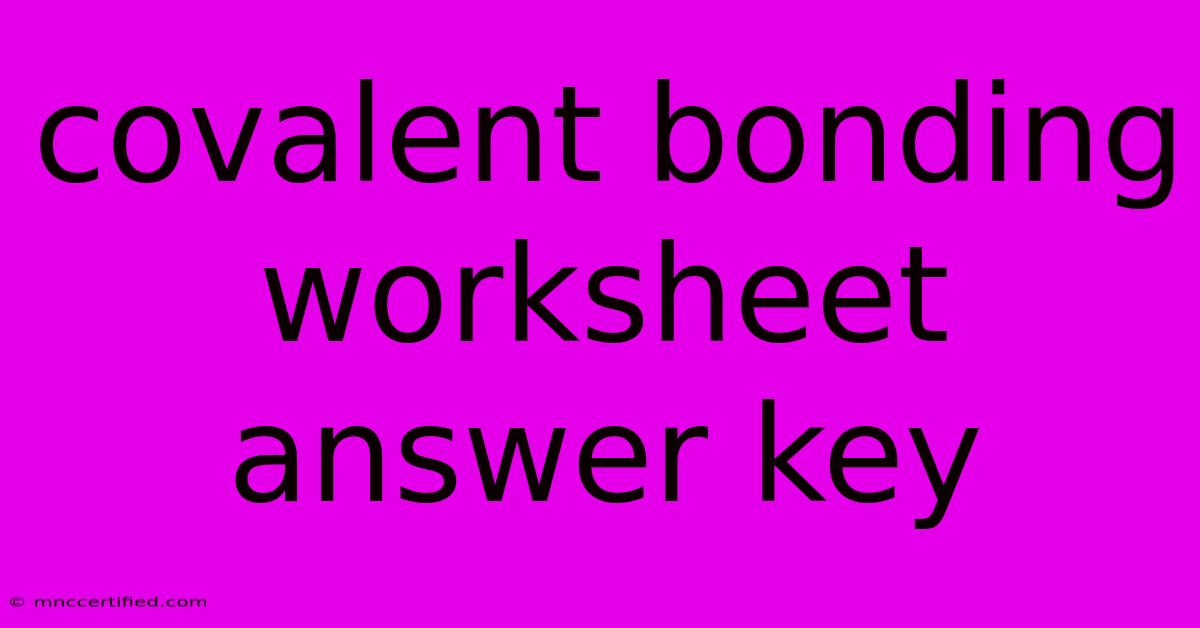Covalent Bonding Worksheet Answer Key

Table of Contents
Covalent Bonding Worksheet Answer Key: Mastering the Basics of Chemical Bonds
Understanding covalent bonding is essential for grasping the fundamentals of chemistry. This type of bond, where atoms share electrons to achieve stability, is prevalent in countless molecules around us. This worksheet answer key aims to help you solidify your knowledge of covalent bonding and its key concepts.
Section 1: Identifying Covalent Bonds
Instructions: For each pair of atoms listed below, determine if they will form a covalent bond.
- 1. H and O: Yes - Both hydrogen and oxygen need additional electrons to achieve a stable electron configuration, making a covalent bond ideal.
- 2. Na and Cl: No - Sodium and chlorine form an ionic bond due to the transfer of electrons.
- 3. C and H: Yes - Carbon and hydrogen form a covalent bond to complete their outer shells.
- 4. Mg and S: No - Magnesium and sulfur form an ionic bond, transferring electrons.
- 5. Cl and Cl: Yes - Chlorine atoms share electrons to achieve a stable octet configuration.
Section 2: Lewis Structures and Covalent Bonds
Instructions: Draw Lewis structures for the following molecules.
-
1. H₂O (Water):
- Oxygen has 6 valence electrons and needs 2 more.
- Hydrogen has 1 valence electron and needs 1 more.
- The Lewis structure shows two hydrogen atoms each sharing a single electron with the oxygen atom, forming two single covalent bonds.
H O H \ / -
2. CO₂ (Carbon Dioxide):
- Carbon has 4 valence electrons and needs 4 more.
- Oxygen has 6 valence electrons and needs 2 more.
- The Lewis structure shows the carbon atom forming two double covalent bonds, sharing two electrons with each oxygen atom.
O = C = O -
3. NH₃ (Ammonia):
- Nitrogen has 5 valence electrons and needs 3 more.
- Hydrogen has 1 valence electron and needs 1 more.
- The Lewis structure shows the nitrogen atom forming three single covalent bonds with three hydrogen atoms, leaving one lone pair on the nitrogen.
H / \ H N \ / H -
4. CH₄ (Methane):
- Carbon has 4 valence electrons and needs 4 more.
- Hydrogen has 1 valence electron and needs 1 more.
- The Lewis structure shows the carbon atom forming four single covalent bonds with four hydrogen atoms.
H / \ H C H \ / H
Section 3: Understanding Polar Covalent Bonds
Instructions: Identify the type of covalent bond (polar or nonpolar) present in each molecule.
- 1. H₂: Nonpolar - Both hydrogen atoms have the same electronegativity, resulting in an equal sharing of electrons.
- 2. HCl: Polar - Chlorine is more electronegative than hydrogen, pulling the shared electrons closer and creating a partial negative charge on the chlorine atom.
- 3. CO₂: Nonpolar - Although the carbon-oxygen bonds are polar, the symmetrical structure of the molecule cancels out the polarity, making it nonpolar.
- 4. H₂O: Polar - Oxygen is more electronegative than hydrogen, creating a partial negative charge on the oxygen atom and partial positive charges on the hydrogen atoms.
Section 4: Covalent Bonding in Everyday Life
Instructions: Give examples of covalent bonds found in everyday life.
- Water (H₂O): Essential for life, water molecules are held together by covalent bonds.
- Carbohydrates (Sugars): Covalent bonds form the backbone of carbohydrates, providing energy for our bodies.
- Proteins: Proteins, crucial for a variety of biological processes, consist of amino acids linked by covalent bonds.
- DNA: The genetic code is stored in DNA, a molecule built on a backbone of covalent bonds.
Conclusion
This worksheet answer key has provided a comprehensive review of key concepts in covalent bonding. By understanding the process of electron sharing, you gain insights into the properties of countless molecules essential for life and technology. As you continue your study of chemistry, remember that covalent bonding forms the foundation for understanding the structure, function, and reactivity of countless compounds.

Thank you for visiting our website wich cover about Covalent Bonding Worksheet Answer Key. We hope the information provided has been useful to you. Feel free to contact us if you have any questions or need further assistance. See you next time and dont miss to bookmark.
Featured Posts
-
Great Florida Insurance Fort Myers Fl
Nov 10, 2024
-
Usa Car Hire Insurance For Uk Drivers
Nov 10, 2024
-
Aston Villa Vs Liverpool Live Premier League Updates
Nov 10, 2024
-
Union Security Life Insurance Company
Nov 10, 2024
-
Current Affairs For Upsc October 28 November 3 2024
Nov 10, 2024